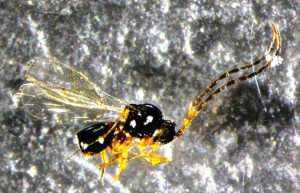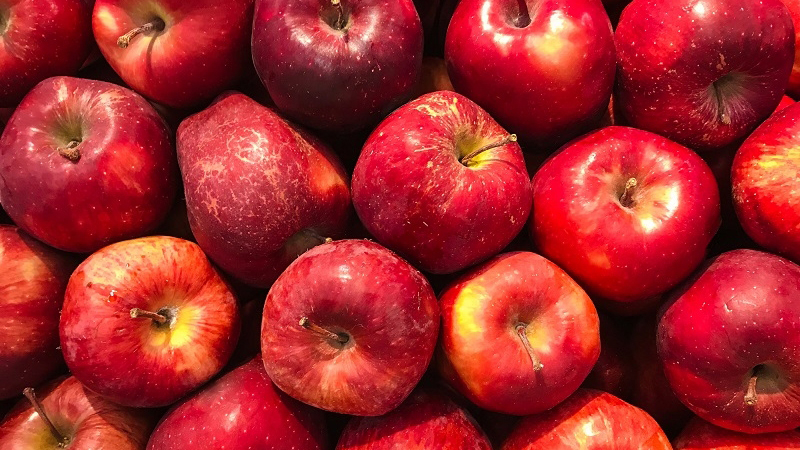Seeking Natural Enemies Abroad

Natural enemies, like this parasitoid found in Oregon, are used to help relieve some pressure from pests like spotted wing drosophila. A research team from Oregon State University is seeking out natural enemies internationally. (Photo credit: Oregon State University)
Insect invaders, like the spotted wing drosophila (SWD), come to the U.S. often without their natural enemies, leaving growers to combat the pest with pesticides. Promising research from Oregon State University hopes to provide a sustainable solution through the use of natural enemies.
“In Asia, (SWD) is not known to be a problem,” says Vaughn Walton, Oregon State University Extension horticultural entomologist and lead investigator of Oregon State’s spotted wing drosophila research. Walton is leading a research team to seek out and import parasitoid specialists to target SWD.
Walton’s research is part of a $5.8 million USDA-SCRI (Specialty Crop Research Initiative) grant, of which the biological control component is one piece. He serves as the project director of Oregon State’s SWD SCRI research project. Another component of the grant is a genome database (See “On The Map”).
Walton sees the identification and gathering of natural enemies as a progression from reaction to advanced management.
“With any new pest that arrives in the U.S., initially it is crisis management,” says Walton. “During these periods, the only option is to focus on management using pesticides, and to economically survive in those first few years. (Now) looking forward, we want more long-term sustainable management methods. One of the most promising methods includes biological control.”
The Process Of Gathering Natural Enemies
Parasitoids, used for biocontrol, are usually found in the country of origin of the pest. Researchers travel internationally to seek out and collect these natural enemies. One technique includes placing sentinel traps that contain the targeted pest to allow attraction and collection of the natural enemies. All collected parasitoids are numbered and cataloged. Then, with necessary permits, they are imported into a secure quarantine facility to the U.S.
As the parasitoids enter the U.S., they are screened in order to determine if they have been correctly collected and packaged by USDA’s Animal and Plant Health Inspection Service (USDA-APHIS) custom control point. Parasitoids are then placed in a quarantine insectary. The next step is to assess the parasitoid’s ability to specifically target SWD. Kent Daane and Xiengeng Wang of University of California-Berkeley are heading up the non-target pest testing of the parasitoids.
“Ideally you want those parasitoids to only be attacking Drosophila suzukii and not any other drosophila,” says Walton. “As soon as that non-target testing and material cleanup is completed, additional release permits are gained before the suitable parasitoid is to be released.”
When approved by USDA-APHIS, a release permit is issued to researchers for the rearing and release of the parasitoid in the locations where SWD is an issue. Walton says the process of approval can take as long as 10 years or as short as one or two years.
“We’re hoping to be able to get through this process at an accelerated rate. In cases where parasitoids are specialists, this may be possible,” says Walton.
Foreign Exploration
Walton says the research team looked at several locations to seek out natural enemies, and will be making three foreign exploration trips. One country where promising materials have been collected is South Korea.
In South Korea, parasitism rates (natural enemies attacking SWD) were as high as 60%, as opposed to in the U.S. where rates are estimated to be as low as 2%.
“Imagine the reduction in pressure if you could get up to 60% parasitism (like in South Korea),” says Walton. “It’s going to have a significant, long-term impact in terms of economic pressure if we can find a good parasitoid.”
Sustainability In Research
“Before spotted wing drosophila arrived in Oregon, growers sometimes were managing pest insects once with a cleanup spray close to harvest,” says Walton. “Now, because of SWD, growers average between five and seven sprays per year, depending on the pressure. This past year, we spent about $14 million just managing the pest.”
Walton sees the research on natural enemies as a key step toward the control and management of SWD in the future. Releasing a parasitoid lowers the SWD pressure, and it also has an economic impact with growers seeing decreased management costs.
“If we are able to establish a suitable biocontrol agent, this agent has an impact that results in savings on a yearly basis,” says Walton. “Even small increases in parasitism rates may result in decreased pesticide dependence and economic and environmental benefits. That’s a huge improvement.”
The Future Of The Project
The USDA-SCRI grant will end in 2015. Walton and his team are preparing to apply for another grant proposal. Walton is also hoping for a new farm bill so that new grant proposals will be accepted.
For now, another foreign exploration trip is planned for this year.
“We need to find solutions such as this in order to ensure the long-term sustainability of our industries and minimize the impact of pests such as SWD,” says Walton. “Techniques such as these will be pivotal to keep our fruit industry competitive.”
On The Map
A Part of the USDA-SCRI SWD grant project is to map and sequence the spotted wing drosophila’s genomes, and to provide access to this sequence for researchers. This online resource, found at spottedwingflybase.oregonstate.edu, allows researchers to search for information on each specific element of the genetic markers specific to the pest’s behavior, pesticide resistance, etc.
Joanna Chiu at the University of California-Davis, is leading the research of the fly’s genetic material.
If a researcher was interested in learning about how quickly SWD develops pesticide resistance, for example, you type in that portion of the genome and it will tell you if one pesticide might develop resistance quicker than another. Eventually those results will be used in application to growers.
The genome mapping could help researchers develop a sensitive trap, designed to SWD’s specific tastes, better targeted pesticides, and with larvae tests
in fruit exports.
More on the SCRI project can be found at http://bit.ly/1gEEiIP and at spottedwing.org.










